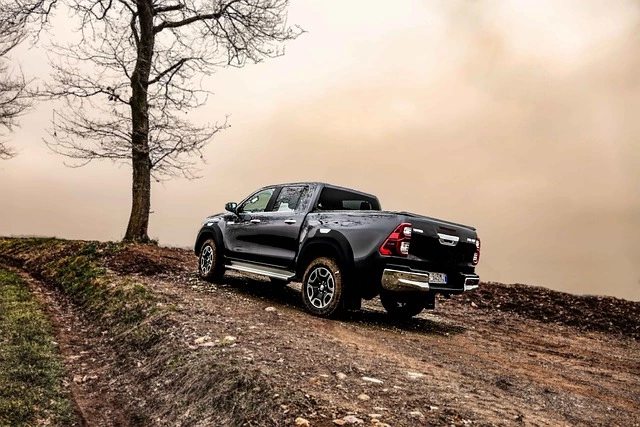| Pros | Cons |
| It breaks very well on dry pavement. | Sometimes lags behind the competition on rocky surfaces and deep mud |
| Brakes well in wet conditions | Snow traction isn’t as good as some of the other options in its class |
| On-road performance is as good as a highway tire, with grippy handling and responsive steering | |
| It offers a quiet and smooth ride, arguably the best in class within the all-terrain category. | |
| Excellent performance in rainy weather thanks to high hydroplaning resistance | |
| Excellent traction and stability on dirt, gravel, and other hardpacked surfaces |
Most SUVs and trucks currently roll with all-terrain tires due to their promising performance on off-road and paved surfaces. However, not every all-terrain tire performs the same. Some excel at the on-road side of the spectrum, while others make no compromises on an off-road track. The tire discussed in this review — the Michelin LTX AT/2 — does well in both areas.
However, its design language indicates that the manufacturers focused more on optimizing its performance on paved surfaces. However, it’s still marketed as a highly capable off-road tire.
Trucks are made for high off-road performance, but they’d be crippled without the right set of off-road tires.
This review will discuss all the notable features of LTX AT/2 and how it performs in different scenarios. Everything from on-road responsiveness and ride quality to off-road capabilities.
Let’s get started.
Michelin LTX AT/2 Features
Michelin has introduced the LTX AT/2 in several P-metric and LT-metric sizes. They range between a wheel diameter of 16 inches to 20 inches. It’s an effective strategy to cover most of the SUVs and trucks out there.
The LT-metric and P-metric load ranges feature two and three steel belts within the internal construction, respectively.
One close look at the tire tells you that they’ve focused their manufacturing efforts on refining your on-road experience. The tread design also prioritizes durability, all-terrain traction, and long tread life despite driving on hardpacked surfaces.
To ensure it works well in colder and warmer climates, Michelin has made the LTX A/T2 out of advanced truck rubber.
The tread design features Michelin’s distinct biting edges for improved grip and traction on surfaces like mud, dirt, wet grass, snow, and grave.
The LTX A/T2, like most other tires from the French manufacturers, is made with Advanced MaxTouch Construction technology. It helps with durability and high performance on the roughest surfaces.
Michelin has used a computer-optimized design to minimalize the vibrations you feel in the cabin while driving on-road. They’ve incorporated their Comfort Control Technology for reduced road noise and bumps.
Performance on dry pavement
As mentioned above, most of Michelin’s efforts on the LTX A/T2 have been channeled on improving your on-road experience with the tire. Thankfully, it seems to have paid off.
There’s a lot of longitudinal traction on dry tarmac, allowing you to accelerate effectively without any notable wheel spin.
You’ll also enjoy the steering response, as it’s significantly better than most other all-terrain tires in its class. There’s also ample traction to ensure effortless cornering and competitive braking distances.
In many ways, it performs more like a typical highway tire than an all-terrain tire on dry paved roads. Surprisingly, it’s super quiet and comfortable too — which goes to show how hard Michelin has tried to get excellent dry road performance out of the LTX A/T2.
Performance on wet roads
Michelin has a stellar track record in producing tires that do well in wet conditions. The LTX A/T2 follows the pattern as well.
Many reviews have rated it to be one of the best all-terrain tires in the rain. It never seems to lose its quick steering response and remains stable on wet roads.
You won’t experience any noticeable wheel spin even in the rain, thanks to the aggressive biting edges. There’s nothing more confidence-inspiring for a driver than stability and excellent traction on wet roads.
Much of it is attributed to the effective hydroplaning resistance of the LTX A/T2 — one of its most significant advantages listed at the top.
With no oversteer and understeer in wet conditions, it’s easily one of the best all-terrain tires in the rain.
Performance on snow
Generally, tires performing exceptionally well on dry tarmac don’t shine as bright on snow. It’s a similar story with the Michelin LTX A/T2.
Tires need to have a softer compound and patterned tread sipes to do well in winter conditions, but the A/T2 has neither of those things.
While similarly priced competition performs better, you can still expect the LTX A/T2s to provide better traction than most highway truck tires in the market.
Off-road performance
Michelin hasn’t ever taken the lead in the off-road tire market segment. The LTX A/T2 represents more of the same.
The tire seems to be targeted towards people who use their trucks primarily for on-road purposes. Competing tires from Goodyear and BFGoodrich take the lead with more aggressive tread designs.
However, they trade off the on-road comfort with significantly bumpier and louder rides than the Michelin LTX A/T2.
With that said, Michelin has vested enough off-road capabilities in the LTX A/T2 to market it as an all-terrain tire.
It provides exceptional stability and traction on a select few hardpacked surfaces, like dirt and gravel. However, it gets outshined by the competition on loose sand and rocky patches.
Conclusion
Whether you should buy the LTX A/T2 from Michelin depends mainly on your priorities. If you’re an absolute off-roading fan, and that’s mostly what you use your truck or SUV for, it’s best to look elsewhere.
However, if you use your truck as a daily driver — the LTX A/T2 has a lot in store for you. The tire mainly focuses on optimizing the on-road ride quality of your SUV or truck. However, it won’t disappoint you on occasional spins on an off-road track.

